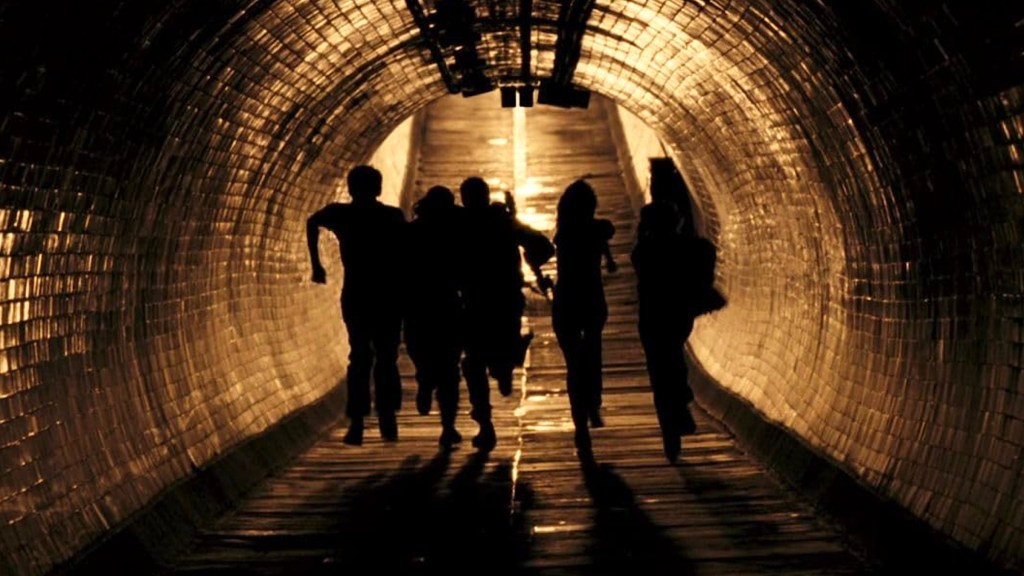
28 Weeks Later, the 2007 sequel to Danny Boyle’s 2002 horror movie 28 Days Later, serves as a superb follow-up to its predecessor while setting up the franchise’s future installments. Set in a post-apocalyptic world, 28 Days Later and 28 Weeks Later revolve around a rage virus pandemic unintentionally released from a laboratory in the United Kingdom, triggering a devastating epidemic that wipes out nearly all of the nation’s people and turns victims into zombie-like creatures. Following 28 Days Later‘s contained narrative about a small group of survivors, director Juan Carlos Fresnadillo’s 28 Weeks Later takes place months after the first film and chronicles the U.S. Army-led effort to repopulate a sector of London. Although the area is believed to be safe, the arrival of an asymptomatic carrier of the virus sparks a new wave of the deadly rage virus.
28 Days Later is a fantastic standalone zombie apocalypse film, and its small-scale story left the opportunity for a sequel to elaborate more on the rage virus and its harrowing impact on the U.K. 28 Weeks Later does exactly that. Despite having an entirely different creative team and set of characters from its predecessor, 28 Weeks Later captures the gritty and terrifying essence of 28 Days Later while raising the stakes and gearing up audiences for more in the future. Truly great horror movie sequels are hard to come by nowadays, but 28 Weeks Later stands out as a perfect successor to 28 Days Later. Ahead of the release of 28 Years Later, fans of the franchise need to revisit this masterpiece.
28 Weeks Later Expertly Continues the Story

Both 28 Days Later and 28 Weeks Later convey similar messages involving non-infected humans acting just as, if not more, horrifically than the infected zombies. After waking up from a coma in an abandoned hospital in 28 Days Later, Jim (Cillian Murphy) bands with Selena (Naomie Harris), Frank (Brendan Gleeson), and Hannah (Megan Burns) to reach the source of a military broadcast offering them safety and a cure only to discover that the soldiers’ leader solely sought to lure in women and make them sex slaves. In 28 Weeks Later, the U.S. Army turns on civilians when Don (Robert Carlyle) catches the virus from his asymptomatic wife Alice (Catherine McCormack) and spreads it to tons of others. Don and Alice’s children, Tammy (Imogen Poots) and Andy (Mackintosh Muggleton) team up with defected U.S. Army sniper Doyle (Jeremy Renner) and medical officer Scarlet (Rose Byrne) as they try to escape incoming firebombs intended to eradicate the area and everyone in it.
The films demonstrate just how depraved and animalistic people become under dire circumstances without becoming infected, a storyline replicated in other zombie apocalypse stories like The Last of Us and The Walking Dead. At the same time, 28 Weeks Later and its sequel are incredibly human stories, as the events of both films see characters help sacrifice themselves for one another, weaving a semblance of hope amid the carnage. 28 Weeks Later separates itself from 28 Days Later by dialing up the horror and intensity. The film teems with dread from its opening flashback scene involving Don’s grueling escape while Alice and others succumb to an infected attack. The zombies in 28 Weeks Later appear more terrifying and bloodthirsty. One disturbing scene after another, spearheaded by Don’s intense and gory contraction of the virus, cements 28 Weeks Later among the scariest zombie movies ever made.
Beyond its frightening imagery and atmosphere, 28 Weeks Later deftly fleshes out the franchise’s lore. In 28 Days Later, not much is known about the virus or how civilization is faring outside of the main characters’ experience. 28 Weeks Later details the fallout of the initial outbreak while introducing the concept of carrying the virus without presenting symptoms, implicating the possibility of a future cure. The broader narrative context in 28 Weeks Later makes for a more compelling story, whereas 28 Days Later relies on isolated plot threads to illustrate its point. 28 Days Later seamlessly models the idea of “simple yet effective,” and 28 Weeks Later fulfills all of the requirements of a great sequel by delivering the same thrills and thought-provoking themes while further developing the franchise’s story at large.
28 Weeks Later Sets Up Even More for the Franchise

Interestingly, Boyle hesitated to confirm that 28 Weeks Later is 100% canon to his original film, written by Alex Garland. Boyle said in a recent interview that “[28 Years Later is] not in conflict [with 28 Weeks Later, but] ‘canon’ [is] not a very Danny Boyle word” and explained that the two movies’ storylines are “not mapped out like a scientific formula.”
It’s amazing that 28 Weeks Later triumphs as a sequel despite only loose connections to 28 Days Later. The follow-up also does well to set up future movies. 28 Weeks Later‘s ominous final scene depicts a horde of infected taking over the streets of Paris, France, revealing that the rage virus has spread to mainland Europe. Thus, there exists a lot of material for 28 Years Later to build upon. Set nearly three decades after the first movie, the upcoming entry will address humanity’s struggle to live among the infected through the eyes of another new set of characters. 28 Years Later could address the status of cured and infected carriers, or Boyle and Garland could take the franchise in a totally different direction, given the standalone nature of both previous movies.
Either way, 28 Years Later promises more grisly action and horrifying zombies as it leads into a 2026 direct sequel, 28 Years Later: The Bone Temple, written by Garland and directed by Nia DaCosta. A stronger sense of narrative continuity between installments appears in store for the renowned horror franchise beginning with 28 Years Later. This should benefit the overarching story as more films come out; however, viewers shouldn’t overlook how 28 Weeks Later heightened the franchise’s brilliance thanks to its elaboration on the rage virus and effective scares, all working in perfect harmony with 28 Days Later.
28 Weeks Later is currently available to stream on Hulu and for free on Tubi. 28 Years Later opens in theaters on June 20th.
The post Why 28 Weeks Later Is the Perfect Sequel to 28 Days Later appeared first on ComicBook.com.

